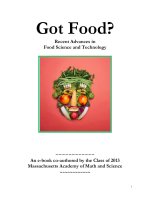Bioluminescence Recent Advances in Oceanic Measurements and Laboratory Applications
Bạn đang xem bản rút gọn của tài liệu. Xem và tải ngay bản đầy đủ của tài liệu tại đây (24.32 MB, 200 trang )
BIOLUMINESCENCE –
RECENT ADVANCES IN
OCEANIC MEASUREMENTS
AND LABORATORY
APPLICATIONS
Edited by David Lapota
Bioluminescence
– Recent Advances in Oceanic Measurements and Laboratory Applications
Edited by David Lapota
Published by InTech
Janeza Trdine 9, 51000 Rijeka, Croatia
Copyright © 2011 InTech
All chapters are Open Access distributed under the Creative Commons Attribution 3.0
license, which allows users to download, copy and build upon published articles even for
commercial purposes, as long as the author and publisher are properly credited, which
ensures maximum dissemination and a wider impact of our publications. After this work
has been published by InTech, authors have the right to republish it, in whole or part, in
any publication of which they are the author, and to make other personal use of the
work. Any republication, referencing or personal use of the work must explicitly identify
the original source.
As for readers, this license allows users to download, copy and build upon published
chapters even for commercial purposes, as long as the author and publisher are properly
credited, which ensures maximum dissemination and a wider impact of our publications.
Notice
Statements and opinions expressed in the chapters are these of the individual contributors
and not necessarily those of the editors or publisher. No responsibility is accepted for the
accuracy of information contained in the published chapters. The publisher assumes no
responsibility for any damage or injury to persons or property arising out of the use of any
materials, instructions, methods or ideas contained in the book.
Publishing Process Manager Martina Durovic
Technical Editor Teodora Smiljanic
Cover Designer InTech Design Team
First published January, 2012
Printed in Croatia
A free online edition of this book is available at www.intechopen.com
Additional hard copies can be obtained from
Bioluminescence – Recent Advances in Oceanic Measurements and Laboratory
Applications, Edited by David Lapota
p. cm.
ISBN 978-953-307-940-0
Contents
Preface IX
Part 1
Oceanic Measurements of Bioluminescence 1
Chapter 1
Long Term Dinoflagellate Bioluminescence,
Chlorophyll, and Their Environmental Correlates
in Southern California Coastal Waters 3
David Lapota
Chapter 2
Seasonal Changes of Bioluminescence in
Photosynthetic and Heterotrophic Dinoflagellates
at San Clemente Island 27
David Lapota
Part 2
Bioluminescence Imaging Methods
47
Chapter 3
Bioluminescent Proteins: High Sensitive Optical
Reporters for Imaging Protein-Protein Interactions
and Protein Foldings in Living Animals 49
Ramasamy Paulmurugan
Chapter 4
Quantitative Assessment of Seven Transmembrane
Receptors (7TMRs) Oligomerization by Bioluminescence
Resonance Energy Transfer (BRET) Technology 81
Valentina Kubale, Luka Drinovec and Milka Vrecl
Chapter 5
Use of ATP Bioluminescence for Rapid Detection
and Enumeration of Contaminants: The Milliflex Rapid
Microbiology Detection and Enumeration System 99
Renaud Chollet and Sébastien Ribault
Chapter 6
Development of a pH-Tolerant
Thermostable Photinus pyralis
Luciferase for Brighter In Vivo Imaging
Amit Jathoul, Erica Law, Olga Gandelman,
Martin Pule, Laurence Tisi and Jim Murray
119
VI
Contents
Chapter 7
Part 3
Chapter 8
Bioluminescence Applications in
Preclinical Oncology Research 137
Jessica Kalra and Marcel B. Bally
Bacterial Bioluminescence 165
Oscillation in Bacterial Bioluminescence 167
Satoshi Sasaki
Preface
As someone who has spent more than 33 years studying the bioluminescence
phenomenon in the world’s oceans, I am continuously amazed by the many
bioluminescence adaptations marine and terrestrial animals have developed to ensure
their existence. It can hardly be considered a random occurrence as it has developed
among various types of organisms, such as single celled dinoflagellates to the much
more complex forms such as shrimp, fish, squid beetles, and worms. Bioluminescence
has many functions, from predator-prey interactions and courtship, to camouflage and
alert status from potential predators.
We now find ourselves utilizing luciferase – luciferin proteins, ATP, genes and the
whole complexities of these interactions to observe and follow the progress or
inhibition of tumors in animal models by measuring bioluminescence intensity,
spatially and temporally using highly sophisticated camera systems. The following
chapters describe applications in preclinical oncology research by bioluminescence
imaging (BLI) with a variety of applications. Two other chapters describe current
methodologies for rapid detection of contaminants using the Milliflex system, and the
use of bioluminescence resonance energy transfer (BRET) technology for monitoring
physical interactions between proteins in living cells. Others are using bioluminescent
proteins for high sensitive optical reporters imaging in living animals, developing pHtolerant luciferase for brighter in vivo imaging, and oscillation characteristics in
bacterial bioluminescence. Lastly, using recent data, two chapters describe the longterm seasonal characteristics of oceanic bioluminescence and the responsible
planktonic species producing bioluminescence. Such studies are few and rare.
I hope that after you read these chapters, many more questions will come to mind,
which will encourage further studies into this fascinating area.
Dr David Lapota
Space and Naval Warfare Systems Center, Pacific
San Diego, California
U.S.A.
Part 1
Oceanic Measurements of Bioluminescence
1
Long Term Dinoflagellate
Bioluminescence, Chlorophyll, and Their
Environmental Correlates in
Southern California Coastal Waters
David Lapota
Space and Naval Warfare Systems Center, Pacific
USA
1. Introduction
While many oceanographic studies have focused on the distribution of bioluminescence in
the marine environment (Stukalin 1934, Tarasov 1956, Seliger et al. 1961, Clarke and Kelly
1965, Bityukov 1967, Lapota and Losee 1984, Swift et al. 1985, Lapota et al. 1988, Batchelder
and Swift 1989, Lapota et al. 1989, Lapota and Rosenberger 1990, Neilson et al. 1995,
Ondercin et al. 1995, Swift et al. 1995), little understanding of the seasonality and sources of
planktonic bioluminescence in coastal waters and open ocean has emerged. Some previous
studies with respect to annual cycles of bioluminescence were severely limited in duration
as well as in the methods used to quantify bioluminescence (Bityukov 1967, Tett 1971). Only
a few studies have measured bioluminescence on an extended basis, and these were short in
duration, usually less than 2 years with long intervals between sets of measurements
(Bityukov 1967, Yentsch and Laird 1968, Tett 1971). Others report data collected at different
times of the year (Batchelder and Swift 1989, Batchelder et al. 1992, Buskey 1991) but do not
address the seasonality of bioluminescence. Thus the detailed temporal variability of
bioluminescence has never been characterized continuously over several years. Lack of such
long-term studies leaves unanswered important questions regarding the role of
bioluminescence in successional phenomena.
To adequately understand, model, and predict planktonic bioluminescence in any ocean,
measurements must be conducted on a continual basis for at least several years in order to
evaluate intra- and annual variability and long-term trends. In this study, bioluminescence
was measured at two fixed stations on a daily long term basis: one in San Diego Bay (SDB)
for 4 years (1992-1996) and the other for 2.5 years (1993-1996) at San Clemente Island (SCI),
located 100 km off the California coast. Additional surface and at-depth bioluminescence
data have been collected on a monthly and quarterly basis at both fixed stations and from a
research vessel to provide a link between coastal and offshore waters. Additional factors
such as seawater temperature, salinity, beam attenuation, and chlorophyll fluorescence were
measured. Plankton collections were made weekly in SDB and monthly at SCI. This study
provides unique correlated coastal and open ocean data collected on a long-term basis
(Figure 1).
4
Bioluminescence – Recent Advances in Oceanic Measurements and Laboratory Applications
2. Methods and materials
2.1 Bioluminescence measurements
Two defined excitation moored bathyphotometers (MOORDEX, University of California,
Santa Barbara) were used in San Diego Bay (SDB) and at San Clemente Island (SCI). Under
control of on-board computers, these measured stimulated bioluminescence, flow rate, and
seawater temperature hourly. Every hour, seawater was pumped for 120 sec at 7-8 L sec-1 for
a total volume of approximately 840 - 960 L of seawater through a darkened cylindrical 5 l
detection chamber approximately 406 mm long and 127 mm in diameter (Case et al. 1993,
Neilson et al. 1995). Bioluminescence, excited by the chamber spanning input impeller, was
measured by a PMT receiving light from 46 fiber optics tips lining the chamber wall and
expressed as photons sec-1 ml-1 of seawater.
On monthly transits between SDB and SCI an "on-board" sensor system sampled
seawater continuously from 3m below the sea surface from a 50m research vessel, the R/V
Acoustic Explorer, measuring bioluminescence, seawater temperature, and salinity
(Lapota and Losee 1984, Lapota et al. 1988, 1989). A vertically deployed bathyphotometer
capable of measuring bioluminescence, temperature, salinity, beam attenuation, and
chlorophyll fluorescence to a depth of 100m was used at 4 month intervals (summer, fall,
winter, spring) at various stations in the Bight to examine the seasonal changes in the
biological and physical structure of the water column (Lapota et at. 1989). Both systems
were calibrated with the luminescent bacteria Vibrio harveyii in a Quantalum 2000 siliconphotodiode detector. The detector calibration is traceable to a luminol light standard
(Matheson et al. 1984).
2.2 Plankton and seawater analysis
Water and plankton samples were collected at 10 stations within the Bight (Figure 1).
Monthly transits were made from March 1994 through June 1996 from SCI to SDB to
measure surface (3m depth) bioluminescence and collect plankton and seawater samples to
determine Chl a content. At SDB, weekly plankton and water samples were taken for 4 years
while monthly plankton and water samples were collected at SCI for 2.5 years. Because
plankton abundance within SDB is usually high, 10 L water samples were concentrated
while 40 l samples were filtered for plankton at SCI. Fifteen-liter water samples were
collected and filtered from select bathyphotometer depths on the quarterly stations (10, 20,
30, 40, 50, 70, and 90 m). This was accomplished by discharging the bathyphotometer's
effluent from its submersible pump through a 130-m long, 2.54 cm (I.D.) hose into a 15 liter
Imhoff settling cone. The bottom of the cone was modified with a valve that allowed water
to be filtered into collection cups fitted with 20-µm porosity netting. One liter of seawater
(unfiltered) was also collected at the each of these depths and frozen in precleaned
polycarbonate bottles for later chlorophyll and nutrient analysis. Plankton samples were
preserved in a 5% formalin seawater solution. Bioluminescent dinoflagellates were
identified to the species level when possible. Chlorophyll a was extracted from the seawater
samples using standard methods (APHA 1981) and measured by fluorescence as an estimate
of biomass on a Turner Model 112 fluorometer (Sequoia-Turner Corp., Mountain View, CA,
U.S.A.) and reported as µg L-1.
Long Term Dinoflagellate Bioluminescence, Chlorophyll,
and Their Environmental Correlates in Southern California Coastal Waters
5
Fig. 1. Bioluminescent study area and cruise track of stations within the Southern California
Bight.
2.3 Upwelling, rainfall, and seawater nutrient data bases
Upwelling indices (North Pacific Ocean wind-driven transports) were collected from 1992
through 1996. The indices were computed for 33°N latitude (Schwing et al. 1996) and
represent monthly average surface pressure data in cubic meters per second along each 100
m of coastline (Bakun 1973, Eppley 1986). Monthly rainfall data were acquired from the
National Weather Service in San Diego. Nutrient and Chl a data were accessed from
archived CALCOFI data (1992-1996) in the Bight and were averaged along CALCOFI lines
90 and 93 which run west from San Diego to the north and south of San Clemente Island
(Hayward et al. 1996). Nitrates (µm L-1) and Chl a (µg L-1) along each of the CALCOFI transit
lines (stations 93-26 to 93.45 and 90-28 to 90.53) were averaged from the surface to a depth of
50m for 12 cruises conducted from September 1992 through April 1995. These data were
used to calculate correlations with bioluminescence, rainfall, and upwelling at SDB.
3. Results
3.1 Mean monthly bioluminescence
Hourly bioluminescence data were averaged for each month. Because minimal
bioluminescence was measured during daylight hours, mean monthly values were based on
data collected from 2100 h (9:00 P.M.) to 0300 h (3 A.M.) the following day.
Seasonal changes in bioluminescence were observed in SDB. Maximum bioluminescence (1
x 108 photons s-1 ml-1 or greater as a threshold) was measured from March through
September for 1993, May through June for 1994, December through May for 1995, and
March through April 1996. Minimum bioluminescence (less than 1 x 108 photons s-1 ml-1)
6
Bioluminescence – Recent Advances in Oceanic Measurements and Laboratory Applications
was measured in January through February for 1993, December through February for 199394, November for 1994-95, and January through February for 1996 (Figure 2).
Fig. 2. Mean monthly bioluminescence trends at San Diego Bay and San Clemente Island
from 1992-1996.
A red tide of the bioluminescent photosynthetic dinoflagellate, Gonyaulax polyedra,
developed in the winter of 1994 along the southern California coast and was correlated with
an increase in bioluminescence in SDB in December and later at SCI in January through
April 1995 (Figure 2). Noctiluca miliaris appeared in the plankton collections at SCI following
this bloom and produced 57% of the bioluminescence in May 1995. Bioluminescence
decreased in SDB during June-July 1995. Mean monthly minimum and maximum
bioluminescence in SDB ranged from 1 x 106 (February 1993) - 4.5 x 108 (June 1993) photons
sec-1 ml-1. Additionally, during the red tide, bioluminescence averaged 1-2 x 108 photons s-1
ml-1 from December through April 1995, a factor of 10 above the normal measured winter
bioluminescence.
In contrast, mean monthly bioluminescence at SCI varied little from August 1993-February
1996 except during the red tide in January 1995 (2 x 108 photons s-1 ml-1) and persisted
through April (Figure 2). Mean monthly bioluminescence ranged from 8 x 106 - 3 x 107
photons s-1 ml-1 at SCI.
3.2 Bioluminescent plankton - San Diego Bay
Most bioluminescence in SDB and SCI was emitted by the photosynthetic dinoflagellates G.
polyedra, Ceratium fusus, Pyrocystis noctiluca as well as from the heterotrophic dinoflagellate,
Noctiluca miliaris, and several species of Protoperidinium. Within SDB, maximum numbers of
bioluminescent dinoflagellates (2430 - 17,216 cells L-1) were collected during the springsummer months while minimal numbers (3 - 2,110 cells L-1) were usually collected in the
winter months for 1992, 1993, and 1995 (Figure 3a).
Long Term Dinoflagellate Bioluminescence, Chlorophyll,
and Their Environmental Correlates in Southern California Coastal Waters
7
Fig. 3. (a) Total and bioluminescent dinoflagellates collected monthly in San Diego Bay from
1992-1996. (b) Percent of total dinoflagellate cells which are bioluminescent collected in San
Diego Bay from 1992-1996.
In most months bioluminescent dinoflagellates represented a substantial percentage of total
dinoflagellates (luminous and non-luminous species) (Figure 3b). Of these, G. polyedra and
Protoperidinium spp. were most abundant; found in the winter, spring, and early summer
months in SDB (Figure 4). Gonyaulax polyedra contributed more than 80% of all luminescent
cells from early summer 1993 (Figure 3b). Ceratium fusus contributed minimally to the total
number of dinoflagellates for the summers of 1993-1994 (Figure 4a). A shift was observed in
the dinoflagellate species composition within SDB with G. polyedra becoming the dominant
species. There were fewer Protoperidinium spp. and C. fusus at SDB in 1994 (Figure 4).
8
Bioluminescence – Recent Advances in Oceanic Measurements and Laboratory Applications
Fig. 4. (a) The numerical abundance of Ceratium fusus and Protoperidinium spp. each month
collected in San Diego Bay from 1992-1996. (b) The numerical abundance of Gonyaulax
polyedra each month collected in San Diego Bay from 1992-1996.
A light budget was calculated to estimate the contribution of light produced by the various
species of bioluminescent dinoflagellates in SDB. Light output from each was measured
with a laboratory photometer system by stirring individual cells for 30 sec (Lapota et al.
1989, Lapota et al. 1992). Mean light output for each species was calculated and then
multiplied by the number of cells found in each of the monthly plankton samples. The mean
light output values for single cells were: G. polyedra 1 x 108 photons; C. fusus 2 x 108 photons,
Protoperidinium spp. 3 x 109 photons, P. noctiluca 1 x 1010 photons, and N. miliaris 2 x 1010
photons. Photons L-1 for each group were plotted from monthly samples collected in SDB
(Figure 5). Bioluminescence from each of the groups (% of total bioluminescence) was then
estimated (Figure 5). Protoperidinium dinoflagellates contributed more than 80% of the
bioluminescence in 41% of all months (n = 51 months) and more than 50% of the
Long Term Dinoflagellate Bioluminescence, Chlorophyll,
and Their Environmental Correlates in Southern California Coastal Waters
9
bioluminescence in 73% of all months. In contrast, G. polyedra contributed more than 80% of
bioluminescence in SDB in only 2% of all months and more than 50% of all bioluminescence
in 18% of all months. Gonyaulax polyedra bioluminescence was most pronounced in the fall
and winter months. Peaks in C. fusus bioluminescence were most pronounced in late
summer and fall, however, the contribution to the light budget was minimal. In 1995 and
1996, G. polyedra dominance in the winter months was followed by an increase in
bioluminescence from N. miliaris which attained concentrations of 95 cells L-1 in March 1995,
186 cells L-1 in April 1995, and 23 cells L-1 in May 1995. This same trend and similar cell
numbers were encountered in the spring months of 1996.
Fig. 5. Bioluminescence produced by each species (photons L-1) monthly in San Diego Bay
from 1992-1996.
3.3 Bioluminescent plankton - San Clemente Island
Numbers of luminescent dinoflagellates were lower at SCI than at SDB, ranging from
3 - 211 cells L-1 of seawater from August 1993 through December 1994 (Figure 6). The
principal species were G. polyedra and several species of Protoperidinium. The red tide was
first observed in January 1995 and persisted through April 1995. Bioluminescence during
this event increased approximately 10 times above former levels for both SDB and SCI,
although this difference was measured at SDB one month earlier than SCI (Figure 2). Total
dinoflagellates and bioluminescent dinoflagellates increased to 16,727 cells L-1 and 15,939
cells L-1, respectively at SCI in January 1995 (Figure 7a). Cell numbers remained high
through April 1995. Gonyaulax polyedra was the predominant red tide bioluminescent
dinoflagellate, however several species of Protoperidinium increased to numbers as high as
674 cells L-1 in February 1995 (Figure 7a). At SCI, bioluminescent dinoflagellates represented
a major percentage of all dinoflagellates collected (Figure 7b). The light budget analysis
indicated that the species of Protoperidinium, again, produced most of the bioluminescence,
followed by Gonyaulax and Ceratium species (Figures 8a,8b). At SCI, Protoperidinium
contributed more than 80% of all bioluminescence for 60% of all months (n = 30 months) and
10
Bioluminescence – Recent Advances in Oceanic Measurements and Laboratory Applications
more than 50% of all bioluminescence for 77% of all months. In contrast, Gonyaulax
contributed 80% of all bioluminescence for just 1 month (3.3% of all months) and 50% of all
bioluminescence for only 10% of the months. During the red tide encountered in the winter
and spring of 1995, G. polyedra contributed 59%, 42%, 58%, 48%, and 27% of all
bioluminescence for the months of January through May 1995, respectively (Figure 8b). As
in SDB, N. miliaris appeared (~2 cells L-1) following the bloom of G. polyedra and produced
57% of the bioluminescence in May 1995 (Figure 8b). The open ocean bioluminescent
dinoflagellate, Pyrocystis noctiluca, was also found in monthly collections. Protoperidinium
spp.were present in greater numbers in the spring and summer months; while G. polyedra
became more prevalent in the fall and winter months.
Fig. 6. The abundance of Protoperidinium spp. and Gonyaulax spp. monthly at San Clemente
Island from 1993-1996.
The light budget analysis (photons L-1) at SDB and SCI correlated with measured
bioluminescence on a daily (photons ml-1 day-1) and monthly (photons ml-1 month-1) basis,
although the light budgets were highly correlated with the later. The light budget analysis
reinforces our understanding of which bioluminescent species contributed to measured
bioluminescence. SCI had the higher correlations (r = 0.876; p < 0.001). This may reflect a
more constant plankton assemblage over time in contrast to a more variable bay
environment where tidal flow into and out of the bay may cause more variation in the
populations sampled (Figure 8)
The change in dinoflagellate species composition between summer and fall is well shown in
the monthly transits where surface (3-m depth) plankton samples were collected at 10
stations each month from July through October 1994 (Figure 9). We observed a gradual shift
in the ratio of Protoperidinium spp. to G. polyedra between September and October (Figure 9).
This trend was also observed in bathyphotometer profiles (0-90 m) for the July and
November 1994 stations across the Bight (Figure 10), with G. polyedra in both instances
dominating in the winter months.
Long Term Dinoflagellate Bioluminescence, Chlorophyll,
and Their Environmental Correlates in Southern California Coastal Waters
Fig. 7. (a) Total and bioluminescent dinoflagellate cells collected monthly at San Clemente
Island from 1993-1996. (b) Percent of total dinoflagellate cells that are bioluminescent
monthly at San Clemente Island from 1993-1996.
Fig. 8. Bioluminescence produced by each species (photons L-1) monthly at San Clemente
Island from 1993-1996.
11
12
Bioluminescence – Recent Advances in Oceanic Measurements and Laboratory Applications
Fig. 9. Dinoflagellate species trends for San Clemente Island to San Diego Bay transits from
July 1994 to October 1994.
Fig. 10. Dinoflagellate species trends for San Clemente Island to San Diego Bay transits from
July 1994 to October 1994.
Long Term Dinoflagellate Bioluminescence, Chlorophyll,
and Their Environmental Correlates in Southern California Coastal Waters
13
3.4 Bioluminescence, temperature, rainfall, and chlorophyll relationships
Seawater temperatures in SDB generally ranged from 14°C to 23°C (Figure 11) while mean
monthly temperatures at SCI ranged from 14.7°C to 20°C (Figure 12). Correlation
coefficients were calculated for both sites. No significant correlations were detected (SDB:
n = 44 months; r = 0.131; p > 0.10) (SCI: n = 30 months; r = -0.241; p > 0.10).
Fig. 11. Mean monthly bioluminescence (photons sec-1 ml-1) and seawater temperature (°C)
at San Diego Bay from 1992-1996.
Fig. 12. Mean monthly bioluminescence (photons sec-1 ml-1) and seawater temperature (°C)
at San Clemente Island from 1993-1996.
3.5 Upwelling indices
Upwelling Indices for 33°N latitude were compared to mean monthly bioluminescence for
SDB (Schwing et al. 1996). These indices are north Pacific wind-driven transports computed
from monthly average surface pressure data in cubic meters of water per second along each
100 meters of coastline (Figure 13). Cold, nutrient rich water containing nitrates and trace
metals are brought to the surface as waters are pushed away from the coast. Nitrates are
limited in surface waters (Holm-Hansen et al. 1966, Armstrong et al. 1967, Strickland 1968),
and are utilized by all phytoplankton for growth (Spencer 1954, Dugdale 1967, MacIsaac and
Dugdale 1969). Inspection of the data shows there is a general trend for upwelling and
bioluminescence to co-occur during the same months for 1993-1994 (February - November)
but not for 1995 and 1996. Correlation coefficients were not significant for both years (1993:
14
Bioluminescence – Recent Advances in Oceanic Measurements and Laboratory Applications
n = 8 months; r = 0.307; p > 0.10), (1994: n = 8 months; r = 0.617; p > 0.10) and all 4 years
(1992-1996: r = 0.111; p > 0.10; n = 47 paired monthly points). Bioluminescence actually
began to increase in the winter of 1994 before the onset of upwelling (Figure 13) which
suggests that some other factor than upwelling may be controlling the onset of maximum
bioluminescence.
3.6 Rainfall effects
Total rainfall for San Diego County from 1992 through 1996 correlated with SDB
bioluminescence. Four years of data (1992-1996) showed that years with the greatest
precipitation also had measurably more bioluminescence at SDB (Figure 14). The year 1995
was different than prior years in that rainfall preceded upwelling (Figure 13) with a marked
increase in bioluminescence. In addition, years with less monthly rainfall (3-4 inches per
month for 1994 and 1996 vs. 8-9 inches per month for 1993 and 1995) exhibited less
bioluminescence. Total bioluminescence (photons ml-1 year -1) at San Diego Bay was
positively correlated with total rainfall (inches year-1) for all 4 years (r = 0.908; n = 4;
Fig. 13. Mean monthly bioluminescence (photons sec-1 ml-1) and upwelling index (m3 sec-1)
for San Diego Bay from 1992-1996.
Fig. 14. Mean monthly bioluminescence (photons sec-1 ml-1) and monthly rainfall (inches
month-1) for San Diego Bay from 1992-1996.
Long Term Dinoflagellate Bioluminescence, Chlorophyll,
and Their Environmental Correlates in Southern California Coastal Waters
15
p <0.05) (Figure 15). Total bioluminescence at SDB was approximately 41% more in 19921993 than in 1993-1994 while 1994-1995 was approximately 66% and 82% greater than in
1993-1994 and 1995-1996, respectively (Figure 16). Bioluminescence at SCI was also 287%
greater in 1994-1995 than in 1993-1994. These data suggest that the development of
bioluminescence were favored by the consequences of rainfall such as storm runoff nutrients
from soil. During the period of 1992 through 1996, of the 77 rain events within San Diego
County, 51 events or 66% of all rain events with > 0.1 inch of rainfall were associated with a
50% increase in bioluminescence within three days of the start of rainfall at SDB. Past
monitoring programs in San Diego County have shown that storm runoff entering coastal
and bay waters during the winter and spring months contains high levels of nitrates and
phosphates as well as other nutrients and metals (City of San Diego Stormwater Monitoring
Program 1994-1995). CALCOFI data sets also show elevated nitrate levels in surface waters
off San Diego along transit lines 90 and 93 following peak rainfall periods.
Fig. 15. Correlation of total bioluminescence (photons ml-1 year-1) and total rainfall (inches
year-1) for San Diego Bay from 1992-1996. (r = correlation coefficient; p = significance level).
Fig. 16. Total bioluminescence (photons ml-1 year-1) measured at San Diego Bay and San
Clemente Island from 1992-1996.









